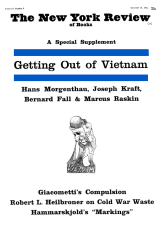In response to:
In Russia's Museums from the August 5, 1965 issue
To the Editors:
The review entitled “In Russia’s Museums” (NYR, Aug. 5, 1965), in the paragraph referring to Shalva Amiranashvili’s “Medieval Georgian Enamels of Russia” leaves the reader with the erroneous impression that Georgian enamels are “Russian art” and in the Russian “native tradition.”
Georgian art cannot be described as belonging to Russia’s cultural heritage since until the XIXth century Georgia was an independent soverign state, and ethnically, linguistically and culturally Georgia is entirely distinct from Russia….
If there is any similarity between the Georgian enamels and Russian art, it is simply because Georgian art and Russian art both developed under the influence of Byzantine art. But Georgian enamels are no more “Russian art” than are the Ravenna mosaics.
In the preface to his book, Amiranashvili makes a very clear distinction between Byzantine, Georgian and Russian enamels. He points out that the art of cloisonné enamels on religious Christian subjects makes its appearance simultaneously in Byzantium and in Georgia at the end of the VIth century, while in Russia it does not appear until the the Xth and XIth centuries.
Your reviewer was perhaps misled by the English title of the book, “Medieval Georgian Enamels of Russia,” a misleading and regrettable title. The French edition (Cercle d’Art) is accurately titled Les Emaux de Géorgie.
Irina Bagration
New York City
This Issue
September 16, 1965



